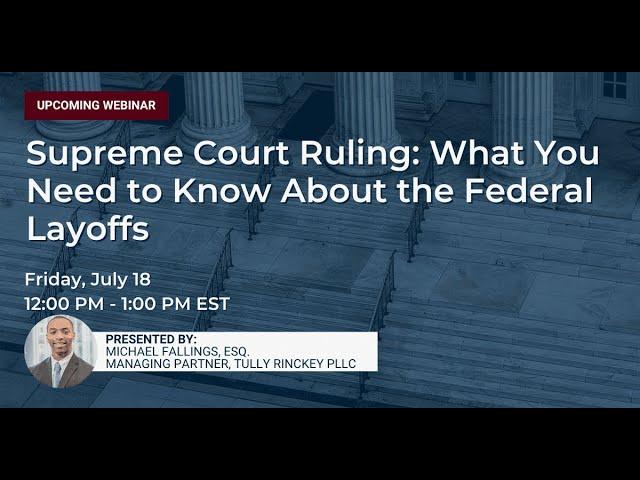In a pivotal ruling, the Supreme Court has lifted a lower court order that had temporarily blocked the federal governmentŌĆÖs planned layoffs under the Trump administration, clearing the way for a significant wave of job cuts across various federal agencies. The decision marks a crucial turning point in ongoing battles over workforce reductions and government restructuring, with wide-reaching implications for thousands of federal employees and the functioning of key departments. This article provides a detailed, real-time account of the developments as they unfold, highlighting the legal, political, and social ramifications of the courtŌĆÖs intervention.
Supreme Court Decision Clears Path for Federal Workforce Reductions
The Supreme Court’s recent ruling has effectively removed a significant legal barrier that had been preventing the Trump administration from proceeding with planned federal workforce reductions. By lifting the injunction that blocked these layoffs, the court has authorized the government to streamline its agencies through mass employee cuts, a move that critics argue could destabilize essential services but supporters claim is necessary for budgetary discipline and increased efficiency.
Among the key implications of this decision are:
- Immediate impact: Hundreds of federal employees face imminent job loss as agencies begin implementing reduction plans.
- Agency restructuring: Departments such as the Department of Energy and the Environmental Protection Agency are expected to see significant staff decreases.
- Political ramifications: The ruling intensifies debates over federal workforce rights and executive power.
| Agency | Estimated Layoffs | Percentage Reduction |
|---|---|---|
| Department of Energy | 850 | 12% |
| Environmental Protection Agency | 500 | 15% |
| Department of Education | 320 | 10% |
Implications of Job Cuts on Government Operations and Public Services
With the Supreme Court’s decision to lift the injunction against federal layoffs, government agencies are now poised to implement extensive workforce reductions. These job cuts threaten to significantly disrupt day-to-day operations across multiple departments, potentially causing delays in critical services ranging from social welfare programs to infrastructure maintenance. Staff shortages could lead to decreased efficiency and longer processing times, affecting millions of citizens who rely on timely government support.
Public services likely to experience the most immediate impact include:
- Processing of benefits such as unemployment and disability claims
- Routine inspections and regulatory enforcement
- Public health initiatives and emergency response coordination
- Administrative support for federal courts and legal proceedings
| Service Area | Estimated Job Loss Impact | Potential Consequence |
|---|---|---|
| Social Services | 25% | Processing delays, reduced access |
| Regulatory Agencies | 20% | Fewer inspections, compliance gaps |
| Public Health | 15% | Lower emergency readiness |
| Judiciary Support | 10% | Court delays and backlog |
Critics argue that the layoffs could exacerbate existing challenges within federal agencies, compounding operational backlogs and eroding institutional knowledge. Supporters of the cuts, however, emphasize governmental budget constraints and the need for organizational leaner structures. As the situation unfolds, the balance between fiscal responsibility and maintaining essential public functions remains a contentious issue at the heart of the national debate.
Legal Context and Challenges Surrounding the Layoff Order
The recent Supreme Court ruling underscores a complex interplay between executive authority and labor protections. The initial block on the layoff order stemmed from concerns raised by public sector unions, which argued that the mass termination of federal employees violated established collective bargaining agreements and federal labor statutes. Legal challenges also emphasized procedural irregularities, claiming that the order circumvented necessary negotiations and impact assessments required under the law.
Amidst this contentious backdrop, several critical legal questions now shape the unfolding landscape:
- Scope of Executive Power: How far can the administration extend authority to execute mass layoffs without Congressional approval?
- Due Process Compliance: Are affected employees guaranteed fair notice and hearing rights before dismissal?
- Implications for Future Labor Relations: Will this decision set a precedent weakening union protections across federal agencies?
| Legal Aspect | Challenge | Current Status |
|---|---|---|
| Collective Bargaining Rights | Alleged breach by unilateral layoff mandates | Pending further litigation |
| Statutory Compliance | Debate over adherence to federal employment laws | Supreme Court ruling allows enforcement |
| Employee Due Process | Concerns about insufficient notification | Under review by federal courts |
Recommendations for Affected Employees and Policy Makers
For employees facing the uncertainty of federal layoffs, it is crucial to proactively prepare by updating resumes, seeking out career counseling services, and exploring unemployment benefits early. Networking within relevant industry groups and attending job fairs can also enhance opportunities for re-employment. Additionally, staying informed about retraining programs sponsored by federal or state agencies may provide alternative career pathways during this transition period.
Policy makers must focus on implementing targeted support measures to mitigate the negative impacts of these mass job cuts. Prioritizing economic stimulus initiatives and investing in workforce development can help sustain affected communities. The following table outlines key policy recommendations designed to address both immediate relief and long-term employment stability:
| Policy Area | Action | Expected Outcome |
|---|---|---|
| Unemployment Benefits | Extend duration and increase payout rates | Financial support during job search |
| Retraining Programs | Fund skill-development workshops | Enhanced employability in new sectors |
| Small Business Grants | Provide incentives for hiring displaced workers | Job creation and economic growth |
- Maintain transparent communication: Keep employees informed about timelines and available resources.
- Encourage public-private partnerships: Facilitate collaboration for job placement services.
- Monitor economic impacts: Adjust policies dynamically based on real-time data.
Insights and Conclusions
As the Supreme CourtŌĆÖs decision lifts the injunction blocking federal layoffs, the path is now clear for the administration to proceed with significant workforce reductions across various government agencies. This move marks a pivotal moment in the ongoing debate over federal employment and budgetary priorities, with implications that will be closely watched by policymakers, unions, and the affected employees. The unfolding developments will continue to shape the landscape of the federal workforce in the months ahead.




